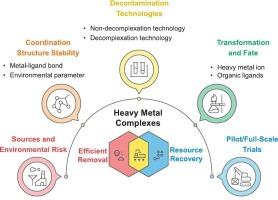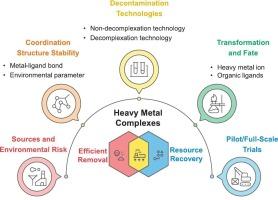Advanced strategies for decontamination of heavy metal complexes from wastewater: Bridging efficient removal to resource recovery
IF 23.5
1区 化学
Q1 CHEMISTRY, INORGANIC & NUCLEAR
引用次数: 0
Abstract
The effective removal of heavy metal complexes (HMCs) remains a critical and challenging issue due to their stable molecular structures, inherent mobility, and high ecotoxicity. A comprehensive understanding of the underlying mechanisms, advantages, and limitations of various strategies for HMC decomplexation and resource recovery from wastewater is crucial, yet remains insufficient. This review first examines the sources and environmental risks of HMCs, followed by an analysis of their coordination structure stability and reactivity. Subsequently, various decontamination strategies are reviewed, encompassing both non-decomplexation and decomplexation techniques (oxidative and reductive), with an emphasis on their mechanisms and comparative strengths and weaknesses. Then, the transformation and fate of heavy metal ions and organic ligands after decomplexation, which are crucial for resource recovery, are discussed. Besides, the current pilot/full-scale trials for HMCs decontamination are also investigated. Finally, prospective research directions for next-generation HMCs decontamination technologies are proposed, providing conceptual frameworks to guide the development of more energy-efficient, integrated approaches aimed at effective removal and resource recovery of HMCs from wastewater.


污水中重金属络合物净化的先进策略:有效去除与资源回收的桥梁
由于重金属配合物具有稳定的分子结构、固有的迁移性和高的生态毒性,其有效去除仍然是一个关键而具有挑战性的问题。全面了解废水中HMC分解和资源回收的各种策略的潜在机制、优势和局限性至关重要,但仍然不够。本文首先综述了高分子材料的来源和环境风险,然后分析了高分子材料的配位结构、稳定性和反应性。随后,回顾了各种净化策略,包括非分解和分解技术(氧化和还原),重点介绍了它们的机制和比较优势和弱点。然后讨论了对资源回收至关重要的重金属离子和有机配体解解后的转化和归宿。此外,还调查了目前正在进行的hmc去污试点/全面试验。最后,提出了下一代hmc净化技术的未来研究方向,提供了概念框架,以指导开发更节能、更综合的方法,旨在有效地去除废水中的hmc并实现资源回收。
本文章由计算机程序翻译,如有差异,请以英文原文为准。
求助全文
约1分钟内获得全文
求助全文
来源期刊

Coordination Chemistry Reviews
化学-无机化学与核化学
CiteScore
34.30
自引率
5.30%
发文量
457
审稿时长
54 days
期刊介绍:
Coordination Chemistry Reviews offers rapid publication of review articles on current and significant topics in coordination chemistry, encompassing organometallic, supramolecular, theoretical, and bioinorganic chemistry. It also covers catalysis, materials chemistry, and metal-organic frameworks from a coordination chemistry perspective. Reviews summarize recent developments or discuss specific techniques, welcoming contributions from both established and emerging researchers.
The journal releases special issues on timely subjects, including those featuring contributions from specific regions or conferences. Occasional full-length book articles are also featured. Additionally, special volumes cover annual reviews of main group chemistry, transition metal group chemistry, and organometallic chemistry. These comprehensive reviews are vital resources for those engaged in coordination chemistry, further establishing Coordination Chemistry Reviews as a hub for insightful surveys in inorganic and physical inorganic chemistry.
 求助内容:
求助内容: 应助结果提醒方式:
应助结果提醒方式:


